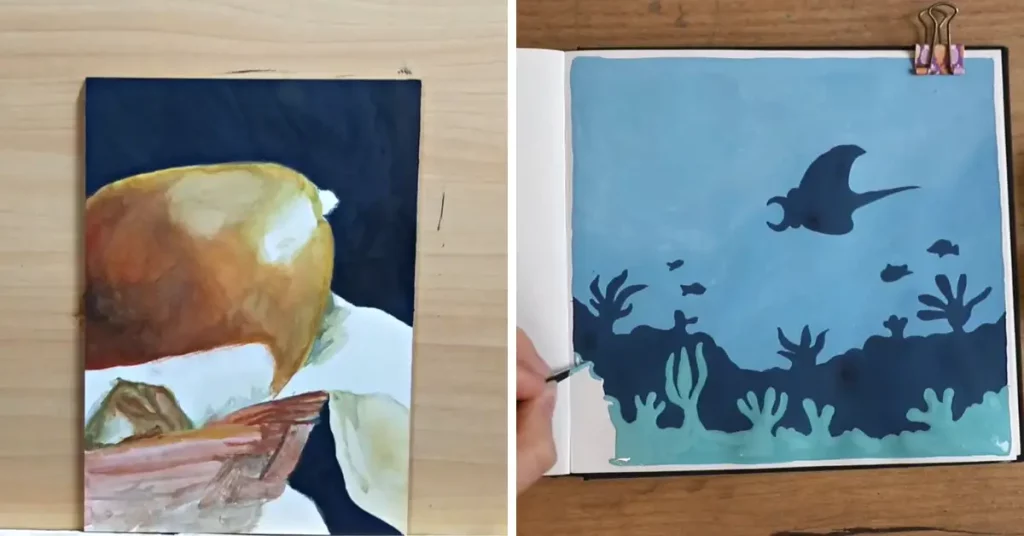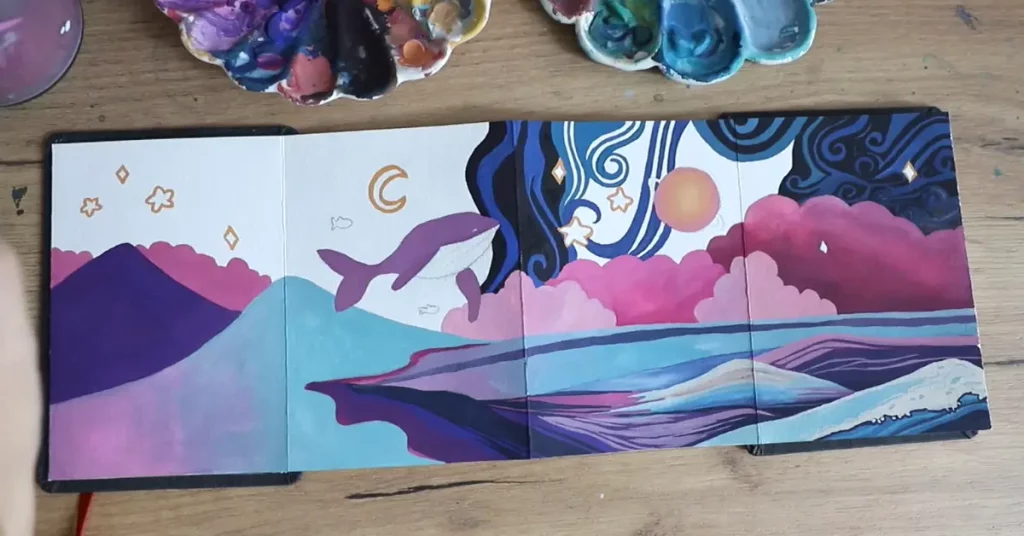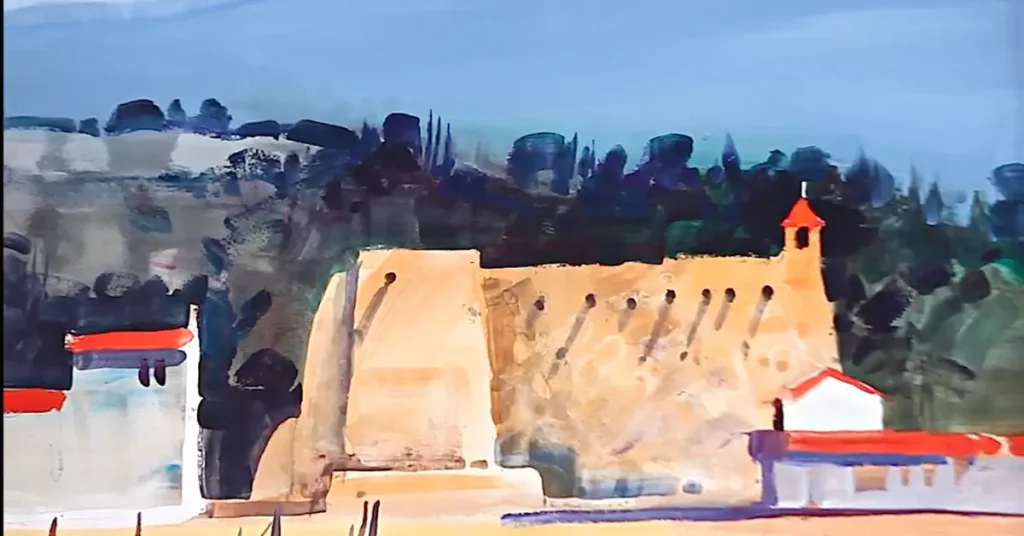The wide variety of colors has made the artistic world more vibrant and impactful. Professional artists always explore different types of colors to create different dimensions. But similarities among colors often make it difficult for beginners to differentiate between them to achieve a particular result. Casein paint and Gouache are such confusing terms. Therefore, I will cover “Casein paint vs. Gouache” in this article. So, what are the differences between Casein paint and Gouache?

Even though Gouache and casein colors are opaque and water-soluble, there are also significant differences. Casein paints have a more creamy texture than Gouache. Moreover, it dries uniformly, which you won’t find in Gouache. Besides, they differ regarding binder, consistency, and color retention capacity.
Check out the entire article to learn about the key characteristics, distinctions, and other necessary information of Casein paint & Gouache. So, let’s start.
What Is Gouache Paint?
Gouache paint vs flashe paint is a popular variety of watercolors. It has long been there but recently gained immense popularity since artists are more interested in workable, re-workable, fast-drying colors.
Gouache paint comprises three vital paint elements: a liquid solvent, a binder, and pigments. It is water-soluble and re-soluble and includes larger pigment particles than those found in watercolors. Therefore, Gouache can provide exceptional opacity, thickness, and finish.

Gouache is unique from other watercolors in that people can use it as basic watercolor and acrylic color. Since it is water soluble, mixing Gouache with more water will create a watery consistency. On the other hand, it exhibits a thick texture in normal conditions due to larger particles of pigments and non-toxic Arabic Gum binder.
Due to the pigments and binder, it provides a sophisticated matte finish that is not sticky. Furthermore, Gouache is a quick-drying paint. That means artists don’t have to wait too long to develop the next layer.
However, gouache paints often crack if thickly applied. Moreover, it has a less tendency to sit smoothly on paper than other types of watercolor. Therefore, manufacturers often use chalk or blanc fixe with the pigments to enhance the smoothness.
Key features of Gouache:
- The paints come in different packaging: tubes, pans, and jars.
- It uses larger particles of pigments and Arabic gum binder.
- It is water-soluble, re-soluble, fast drying, and easy to work.
- It offers a rich matte finish with excellent coverage.
- The paints generate brightness from the pigment & paint film’s outer layer instead of the paper’s white surface.
- If applied too thickly, it may crack.
What Is Casein Paint?
Casein is one of the ancient opaque paint. The earliest Egyptian and Chinese artists used it as an adhesive. But later, they found that it could function as paint when mixed with pigments. Since then, it has become a popular paint. During the 1930s and 1940s, people immensely used it as house paint.

Casein is a protein found in milk that gives it a whitish tone. The paint got its name from this protein since it uses a protein-based binder. It is also water-soluble, and users don’t need to use any chemical solvent to thin the color. But one can use water to make it more flexible. Regarding texture, the paint provides a creamier-matte finish, just like oil and acrylic paints. It is not sticky and dries within a few hours to proceed with the next step.
The paint is more durable than oil paint since it becomes moisture-resistant over time. Another fascinating feature of casein paint is that it is amendable. Artists can modify any object by rubbing the area with a damp cloth. Furthermore, one can also use an ammonia mixture (ammonia: water= 1:9 parts) for a complete cure.
Casein paint is ideal for various solid and non-oily surfaces, such as canvas panels, illustration boards, wood panels, metal, cement, hard water paper, walls, plaster, glass, etc.
Key features of Casein Paint:
- It is a protein-based paint.
- Casein provides a rich, non-sticky, creamier-matte finish.
- It dries faster and becomes moisture-resistant.
- Casein paint is amendable.
- It is less manipulative than Gouache paint.
- It is ideal for any non-oily surface that has no issue with water.
Casein paint vs. Gouache
From the above-mentioned sections, you have already got an overall idea about Casein and Gouache paints. Now I have listed the key differences between these two below. So, let’s have a look:
| Criteria | Gouache | Casein paint |
| Function | It can act both as a watercolor and acrylic color | It works more like oil paints |
| Finishing effect | It offers a matte finish | It offers a creamy matte finish |
| Color consistency | Smooth | Smoother |
| Reactivation | Gouache needs water to reactivate | It does not reactivate with water |
| Color retention capacity | Average | Outstanding |
| Binder | Arabic Gum | Protein-based binder |
| Suitable for | Paper | All types of non-oily surface |
| Effects for thick application | Crack or peel | No crack or peel |
| Color manipulation capacity | More manipulative | Less manipulative |
Final Verdict:
The availability of different types of paints has diversified the art world. Though many people want to explore this world, they are unable to successfully achieve their desired goals because of their indifference to color types.
With a few exceptions, there are many similarities between gouache and casein paints, where people need some clarification. Therefore, I have gone over “Casein paint vs. Gouache” in this article. Besides, I have provided the key features and main differences between them. I hope the readers can now accurately differentiate between these two and put the knowledge to produce more excellent outcomes.

S. Pushon is a paint expert, self-taught artist, and currently working as an adviser in the paint industry as a Quality Improvement and Development Assistant.
An artist by heart, he draws remarkable art pieces and as a professional paint industry individual, he seeks the insight and shares with enthusiasts. Read more…

